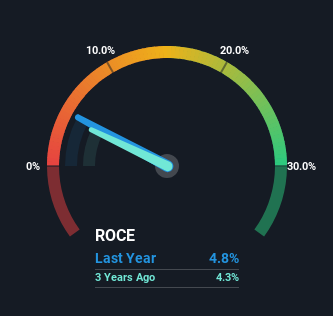Stock Analysis
- United States
- /
- Professional Services
- /
- NasdaqGS:FA
Returns On Capital At First Advantage (NASDAQ:FA) Have Stalled

There are a few key trends to look for if we want to identify the next multi-bagger. Typically, we'll want to notice a trend of growing return on capital employed (ROCE) and alongside that, an expanding base of capital employed. Put simply, these types of businesses are compounding machines, meaning they are continually reinvesting their earnings at ever-higher rates of return. Although, when we looked at First Advantage (NASDAQ:FA), it didn't seem to tick all of these boxes.
Return On Capital Employed (ROCE): What Is It?
Just to clarify if you're unsure, ROCE is a metric for evaluating how much pre-tax income (in percentage terms) a company earns on the capital invested in its business. Analysts use this formula to calculate it for First Advantage:
Return on Capital Employed = Earnings Before Interest and Tax (EBIT) ÷ (Total Assets - Current Liabilities)
0.048 = US$83m ÷ (US$1.8b - US$90m) (Based on the trailing twelve months to June 2023).
So, First Advantage has an ROCE of 4.8%. Ultimately, that's a low return and it under-performs the Professional Services industry average of 12%.
Check out our latest analysis for First Advantage

In the above chart we have measured First Advantage's prior ROCE against its prior performance, but the future is arguably more important. If you'd like, you can check out the forecasts from the analysts covering First Advantage here for free.
How Are Returns Trending?
In terms of First Advantage's historical ROCE trend, it doesn't exactly demand attention. Over the past three years, ROCE has remained relatively flat at around 4.8% and the business has deployed 64% more capital into its operations. Given the company has increased the amount of capital employed, it appears the investments that have been made simply don't provide a high return on capital.
The Bottom Line On First Advantage's ROCE
As we've seen above, First Advantage's returns on capital haven't increased but it is reinvesting in the business. Unsurprisingly then, the total return to shareholders over the last year has been flat. Therefore based on the analysis done in this article, we don't think First Advantage has the makings of a multi-bagger.
First Advantage could be trading at an attractive price in other respects, so you might find our free intrinsic value estimation on our platform quite valuable.
While First Advantage may not currently earn the highest returns, we've compiled a list of companies that currently earn more than 25% return on equity. Check out this free list here.
Valuation is complex, but we're helping make it simple.
Find out whether First Advantage is potentially over or undervalued by checking out our comprehensive analysis, which includes fair value estimates, risks and warnings, dividends, insider transactions and financial health.
View the Free AnalysisHave feedback on this article? Concerned about the content? Get in touch with us directly. Alternatively, email editorial-team (at) simplywallst.com.
This article by Simply Wall St is general in nature. We provide commentary based on historical data and analyst forecasts only using an unbiased methodology and our articles are not intended to be financial advice. It does not constitute a recommendation to buy or sell any stock, and does not take account of your objectives, or your financial situation. We aim to bring you long-term focused analysis driven by fundamental data. Note that our analysis may not factor in the latest price-sensitive company announcements or qualitative material. Simply Wall St has no position in any stocks mentioned.
About NasdaqGS:FA
First Advantage
First Advantage Corporation provides employment background screening, identity, and verification solutions worldwide.
Moderate growth potential with mediocre balance sheet.

